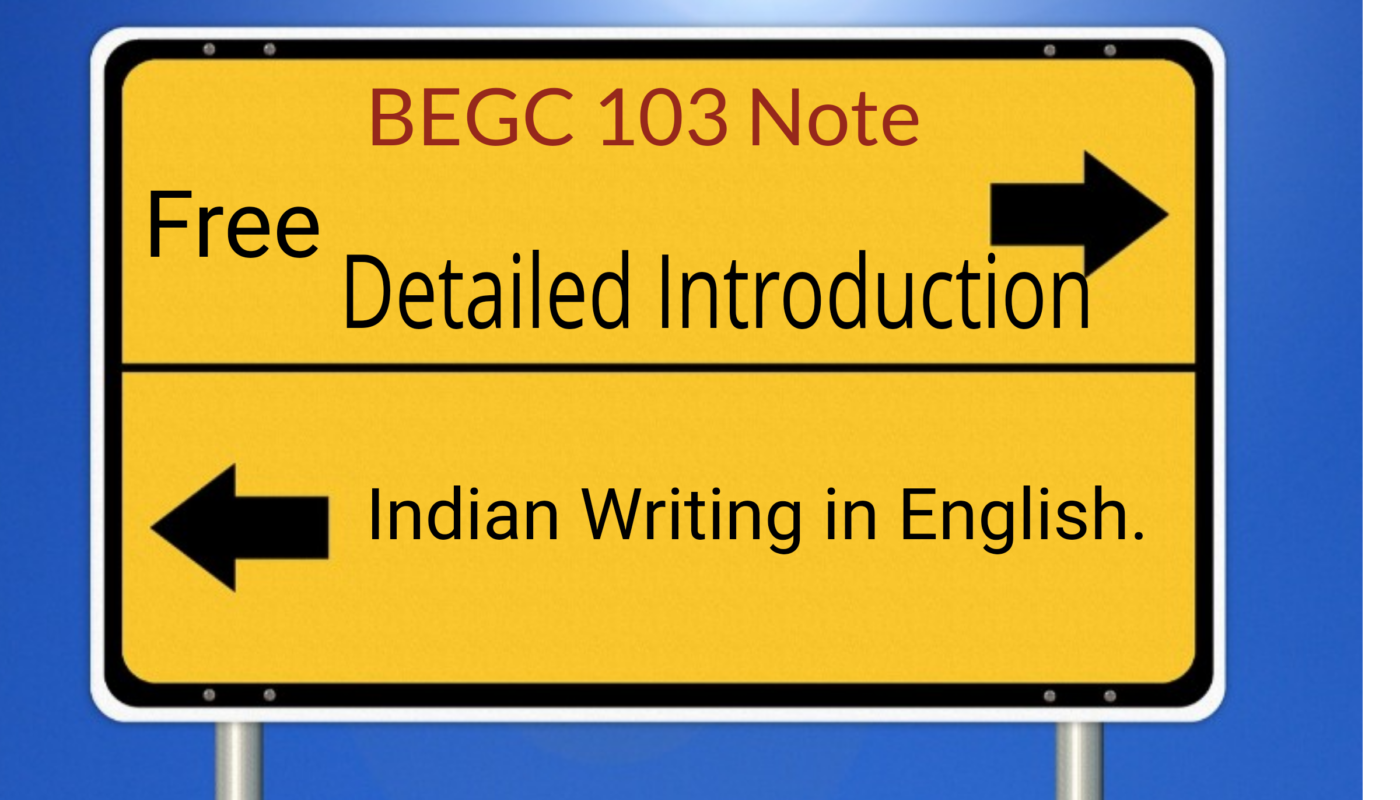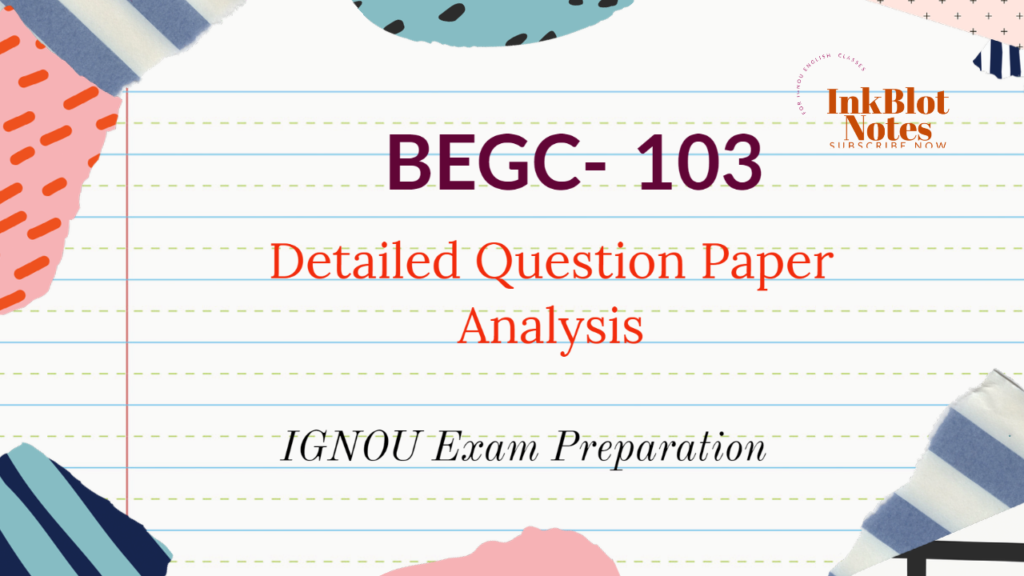An Introduction to BEGC- 103 Indian Writing in English
This is a detailed note on BEGC 103, one of the IGNOU English courses under the BA English program. This is a course prescribed for the second semester BA English students at Indira Gandhi National Open University. We provide you with simple and comprehensive notes on BEGC-103 Indian Writing in English. Now let’s have a discussion on Block number one unit 01.
Indian writing in English is a collection of works by Indian writers who write in the English language but use one of the Indian languages as a mother tongue. It also consists of the work of Indian writers who were born in India but residing in foreign countries. Raja Rao and Salman Rushdi are examples of such writers. Raja Rao was born and brought up in Mysore but settled in France.
Visit BEGAE-182 English Communication Skill Online Classroom
Indian writing in English brings a great impact on various forms of literature like poetry, novel, play, etc. Many Indian writers considered English as a medium of expressing indigenousness in front of the world. In other words, some writers in Indian writing considered English literature as a tool or method to express Indian tradition, culture, and heritage. Such a reflection can be seen in the works of many writers like RK Narayan, Mulk Raj, Anand Raja Rao, Arundhati Roy, Salman Rushdie, etc.
BEGC 103 Related Links
- BEGC-103 Previous Question papers
- BEGC 104 Previous question Papers.
- BEGAE-182 Question Paper.
- BEGAE-182 Solved Assignment 2022-23
Many Indian writers have received International recognition as well. Rabindranath Tagore received Nobel Prize for Gitanjali in 1913.
Salman Rushdi received the Booker Prize for his novel, Midnight Children in 1981.
Arundhati Roy received the Booker Prize for her novel, The God of Small Things in 1997.
- Some notable novelists in Indian English literature are:
- RK Narayan.
- Anita Desai
- Vikram Seth
- Mulk Raj Anand
- Amitav Ghosh
- Khushwant Singh
- Raja Rao
- Mahesh Dattani.
- Sarojini Naidu.
- Nissim Ezekiel.
- Kamala Suraya.
- Shashi Tharoor. etc.
Block 01 A Tiger for Malgudi.
This block provides you with a detailed study of RK Narayan’s A Tiger for Malgudi. Before discussing the novel the first unit gives you an introduction to the Indian English Novel. This course has been divided into four blocks each block containing four units.
IUNIT 01 Introduction to the Indian English Novel.
Indian novelists can be categorized into three groups (based on the coursebook) such as pre-independence novelists, post-independence, and women novelists.
Pre-independence Indian Novelists.
THE FIRST INDIAN ENGLISH NOVEL
- Indian English novels took birth in the pre-independent era.
- Bankim Chandra Chatto Padhyaya was the first Indian writer who wrote a novel in the English language.
- He was a Bengali writer.
- Rajmohan’s Wife was the first novel, that was firstly published in Kolkata weekly, The Indian Field.
- In 1930 It has published in the form of a book later republished in 1990.
- It is a social novel set in a rural part of Bengal
- This novel exposes the negative impact of marriage on Indian women.
- It is a story of a Bengali woman, Matangini, who is oppressed by her husband Rajmohan.
If we come across the early Indian novels, we have to emphasize three names, such as Mulk Raj Anand, RK Narayan, and Raja Rao.
They were dominated in Indian English Novels before the independent era.
Therefore they had a great influence on the development of the Indian English Novel.
THREE SIGNIFICANT NOVELISTS
- Mulk Raj Anand (1905-2004)
- He wrote six novels and 12 collections of short stories.
- He always expresses social commitment through his Novel.
- This means he always exposes social injustice like untouchability in front of the readers.
- The majority of his heroes or protagonists belong to the working class like sweepers, Coolies and plantation workers. For example.
- Munoo in Coolie (1936).
- Backha in Untouchable (1935).
- Major Works.
- Untouchable(1935)
- Coolie(1936)
- The Village( 1939)
- Two Leaves and a Bud (1937)
- The Big Heart (1945)
- RK Narayan
- Born in Madras in 1906
- He was a full-time writer and writing was considered a profession.
- He wrote 15 novels, five collections of short stories, two travel books, four collections of essays and a memoir.
- He presents a wide variety of Indian life through his literary works.
- The majority of his novels are set in an imaginary, small town, Malgudi which represents villages in South India.
- Malgudi is a fictional place that reflects Indian society with varieties of cultures, beliefs and superstitions.
- His major novels.
- Swami and Friends(1935)
- Vendor of Sweets (1967)
- The English Teacher (1945)
- Waiting for Mahatma (1955)
Raja Rao (1908- 2006)
- The majority of his time was spent abroad, especially in Europe.
- He wrote both in English and French.
- Nationalism is one of the important themes reflected in his novels.
- Kanthapura (1938) is his first novel.
- It reflects on the theme of nationalism.
- It propagates Gandhian ideology and teaching.
- It teaches us the Gandhian way of protesting against the British administration.
Post-independence Indian Novelists.
This section talks about the novelists who belong to the post-independent period, especially male novelists. After this section, we will discuss female novelists as well.
Let us have a look at some of the post-independence male novelists.
Bhabani Bhattacharya (1906- 1988)
- Earliest novelist of the independence era.
- Wrote novels for social purposes.
- His novels are always showcasing the exploitation and cruelties of Britishers on Indians.
- Novels.
- So Many Hungers (1947)
- His first novel.
- He Who Rides a Tiger(1952)
- So Many Hungers (1947)
Khushwant Singh ( 1915- 2014)
- Born in Hadali, now in Pakistan.
- He was a lawyer in Lahore
- He has written a few short stories, a couple of novels, etc.
- Novels.
- Train to Pakistan(1956)
- It brings literary fame for him.
- It is a famous partition novel( India and Pakistan)
- It highlights the theme of partition between India and Pakistan.
- Portrays horror and violence related to partition.
- The novel is set in a place called Mano Majra( border of Pakistan)
- This novel shows how communal harmony is disturbed by the partition of India.
- Train to Pakistan(1956)
Arun Joshi (1939-1993)
- He was influenced by French writer Camus and his theory of Existentialism.
- The majority of his novels deal with existentialism.
- The majority of his works reflect the theme of conflict and self-identity
- Novels.
- The Foreigner (1968)
- The Strange Case of Billy Biswas (1971)
Salman Rushdie (1947)
- Grew up in Mumbai
- Started his writing career with a science fiction, Grimus.
- He is a controversial figure because of his treatment of sensitive issues like religion and politics.
- He won the Booker Prize in 1991 for his Novel Midnight Children.
- He was selected as Bookers’ Booker in 1993.
- Midnight Children(1981)
- Considered his best novel.
- Awarded Booker Prize in 1991.
- In the novel, he describes the history of India from 1910 to 1971.
- In the novel, he uses the technique of magic realism.
- The novel blend of comedy and tragedy.
- There is an innovative use of language by mixing both native languages with English.
- Shame (1983)
- It talks about contemporary Pakistan politics.
- The Satanic Verses (1988)
- Another controversial novel.
Amitav Ghosh (1956)
- Born in Kolkata, Bengal.
- The Shadow Lines(1988)
- It has been written based on his own experience.
- This novel portrays private and public events in three countries- India Pakistan and Bangladesh.
- Because he spent his life in these three countries.
- In the novel, he unfolded his memories one by one.
- The Shadow Lines(1988)
- The Circle of Reason(1986)
- Hungry Tide (2004)
Upamanyu Chatterjee 1959.
- Born in Patna, Bihar.
- Retired civil service officer.
- His novels are always fun and heart-touching alike.
- He emphasizes the portrayal of the life of middle-class people.
- Sense of humor and amazing language are the features of his Novel.
- English, August: An Indian Story(1988)
- The best novel of Upamanyu Chatterjee.
- He picturizes the westernized Indian’s life.
- It tells the story of Agastya Sen, an Indian Civil Servant, whose thoughts are always dominated by literature women and soft drugs.
- The Last Burden (1993)
- The Memories of the Welfare State (2000)
Vikram Seth 1952
- Born in Kolkata, Bengal.
- He has contributed to prose, poetry, and travelogues.
- He wrote some novels as well.
- A Suitable Boy (1994)
- This novel brought him public fame.
- Highlights the theme of communal disharmony after the partition of India.
- Apart from that, he discusses corruption and the conflict between modernity and tradition.
- It is a story of a Hindu woman, Lata, and a Muslim boy Kabir.
- The woman Lata has to suffer a lot between her mother’s wishes and her love for a Muslim boy.
Amith Choudhary (1962)
- Born in Kolkata, Bengal
- He has contributed to different forms such as poetry, fiction, reviews, and novellas.
- He Drew characters from life in Kolkata.
- Apart from that as selected characters in his Novels from different age groups.
- A Strange Sublime Address (1991)
- About life in Kolkata.
- The 10-year-old boy is the major character in the story.
- The novel tells the story through the eyes of 10 years old Bombay boy, Sandeep.
Women Novelists.
After independence, there is a number of novels by women writers. These female writers highlight women as the central figures in their works. Nayantara Sahgal., Anita Desai, Ruth Prawer Jhabvala, Kamala Marrkandaya, and Arundhati Roy are some writers of the post independent period. Now let us have a short note on each writer.
Kamala Markandaya (1924- 2004)
- Born in Mysore Karnataka.
- Educated at Madras.
- She is a novelist and journalist.
- After the marriage settled in London.
MAJOR NOVELS
Nectar in a Sieve 1954.
- Her first novel.
- It reveals her experiences in India.
- It presents socio-economical changes after 1947.
- This novel focuses on the story of a woman living in poverty in rural India.
- This is a story of a peasant woman, Rukmani, and her love for her husband, Nathan.
- Rukmani is the protagonist of the novel, she struggles for survival.
- It was a big commercial success.
Other Novels.
- Some Inner Fury1955)
- A Science of Desire (1963).
- Possession(1963)
- Nowhere Man (1972)
- The Pleasure City (1984)
Shashi Deshpande (1938)
She has an important place among Indian women writers.
- Born in Karnataka.
- Shashi Deshpande began her carrier with short stories and later developed as a novelist.
- All of her novels deal with themes of the inner conflict of women,men-women relationships, and parent-child relationships.
- The majority of her novels deal with the mental conflict of the middle-aged educated woman.
Major novels.
- Rootes and Shadows(1983)
- The Dark Holds No Terrors (1980)
- Come up and Be Dead (1982)
- Small Remedies(2000).
- That Long Silence.
- This novel won Sahitya Academy Award in 1090
- This is a story of a middle-aged woman, Jaya who lived with her husband Mohan and two children.
- She was an educated woman.
- Jaya is a victim of gender discrimination and patriarchy
- Before her marriage, she was a clever and smart girl.
- After her marriage, she became speechless and lost her voice.
- This novel questions the way how Indians treat women in society.
Ruth Prawer Jhabvala (1927-2013)
Another contemporary woman novelist was born in a German Jewish family in 1927.
- She married an Indian architect and settled in New Delhi.
- She pictured Indian life, like any other Indian writer.
- She was a novelist, short story writer, and screenwriter.
- She wrote eight novels, a collection of four short stories, and a few screenplays.
MAJOR NOVELS
- To Whom She Will(1955)
- The Nature of Passion (1956).
- The House Holder(1916)
- Get Ready for Battle(1962)
- Heat and Dust(1975)
- The most well-known work.
- It presents a romantic relationship between east and west.
- This novel is set in two eras or periods- colonial Indian and independent India.
- It tells the life of two Indian women.
- It tells us the emotions or feelings and problems of women in two different eras in Indian history.
- It presents rich Indian life in one part and, poverty and superstition on the other hand.
Other Related Links
- BEGAE 182 Online Classroom
- BEGAE-182 Solved Assignment 2022-23
- BEGAE-182 Solved Question Paper
- Download all IGNOU BA English previous question papers.
- BEGC 103 Previous question papers
- BEGC 103 Important questions and answers
- IGNOU Assignment Front Sheet\ Evaluation Sheet.
- IGNOU Assignment Personal Data Sheet



